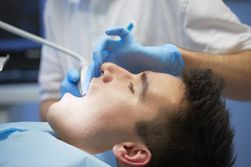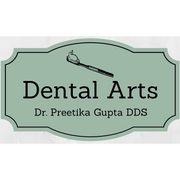
According to the NYU Oral Cancer Center, approximately 30,000 cases of oral cancer are diagnosed every year. There are multiple variations of oral cancer but they react well to treatment, especially when detected quickly by a dentist. By knowing the causes and symptoms, you’ll be able to notice signs of the disease while it’s in its most treatable form.
What’s Oral Cancer?
What Are the Symptoms?
Oral cancer can develop on the lips, cheeks, tongue, and floor of the mouth. It can also reach the soft and hard palate, the sinuses, and the throat.
 The disease usually starts as a sore inside the mouth that doesn’t heal even after several weeks. Sores may also develop on the face and neck, and are prone to bleeding. Areas of the mouth, including the gums and lip, may begin to swell and erode. Speckled red and white patches may also appear throughout the mouth.
The disease usually starts as a sore inside the mouth that doesn’t heal even after several weeks. Sores may also develop on the face and neck, and are prone to bleeding. Areas of the mouth, including the gums and lip, may begin to swell and erode. Speckled red and white patches may also appear throughout the mouth.
Some symptoms also include unexplained bleeding inside the mouth, and sudden numbness or pain around the mouth, face, and neck. You may also experience a soreness or feeling that something’s lodged in the back of your throat.
Chewing and swallowing will become difficult, and the way your teeth fit together may change. When speaking, your voice may sound rough or be noticeably different.
Oral cancer may also affect the rest of your body. Those experiencing the disease have reported ear pain and substantial weight loss in a short time.
By scheduling bi-annual check-ups with your dentist, or reaching out to them when these symptoms first occur, oral cancer can be caught and treated in its early stages.
What Types of Oral Cancer Are There?
Squamous Cell Carcinoma
Like its symptoms, oral cancer has a variety of forms. Squamous cell carcinoma is the most common form, accounting for 90% of oral cancer diagnoses. Squamous are small, flat cells that look like fish scales when examined under a microscope.
Squamous cells occur naturally in the body, lining hollow organs, along with the respiratory and digestive tracts. Outside the body, they’re seen on the areas of the skin that’s most often exposed to the sun—the neck, ears, and face.
In oral cancer cases, the squamous cells become abnormal and line the mouth and throat.
Oral Verrucous Carcinoma
This is a very rare subtype of squamous cell carcinoma, appearing in less than 5% of all oral cancer diagnoses.
Like squamous carcinoma, verrucous carcinoma can cause voice hoarseness, sore throat, and difficulty swallowing. It most often appears in the oral cavity, but may also occur in the larynx, throat, and nasal cavity.
 However, its symptoms largely revolve around inflammation. The cauliflower-like lesions that form most often occur in areas of chronic inflammation. Those with a history of oral ulcers and chronic cases of candidiasis are more likely to develop verrucous carcinoma.
However, its symptoms largely revolve around inflammation. The cauliflower-like lesions that form most often occur in areas of chronic inflammation. Those with a history of oral ulcers and chronic cases of candidiasis are more likely to develop verrucous carcinoma.
Oral Melanoma
Melanoma is predominantly known as a form of skin cancer, usually appearing on the head and neck. However, it can also occur in nasal and oral cavities, as well.
Lymphoma
The lymph tissue is part of the immune system. When oral cancer-related lymphoma forms, it’s often on the tonsils or at the base of the tongue, which contain lymphoid tissue.
Minor Salivary Gland Carcinomas
Several types of cancers can develop from the salivary glands located throughout the mouth and throat. Approximately 30% of patients with salivary gland carcinomas are diagnosed with mucoepidermoid carcinoma, making it the most common form of oral salivary cancer.
Mucoepidermoid carcinoma has fast- and slow-developing variants. Early detection by a dentist is vital in the successful treatment of the disease.
Benign Oral Cavity Tumors
Sometimes, non-cancerous tumors and growths develop in the oral cavity. Among the most common are papilloma, hemangioma, lymphangioma, fibroma, and lipoma. While they’re benign, they should be removed upon detection. When left unchecked, the lesions can form into cancer.
Erythroplakia and Leukoplakia
These are also non-cancerous developments that should be treated upon detection. Erythroplakia creates a red lesion that bleeds when touched. Leukoplakia has a white area. Nearly 70% of erythroplakia cases develop into cancer, while 25% of leukoplakia cases are found to be pre-cancerous when screened through a biopsy.
Who’s Vulnerable to Oral Cancer & How Does it Develop?
Gender & Age Factors
Men are twice as likely to develop oral cancer than women because men are more likely to smoke and drink for longer and at a heavier rate than women. Both men and women are at an increased risk of developing the disease when they’re over the age of 45.
Substance Use
As with many forms of the disease, the development of oral cancer is affected by tobacco and alcohol use. Smoking cigarettes and marijuana will increase the odds of oral cancer developing. However, those who use chewing tobacco are at the greatest risk.
Chewing tobacco (also known as snuff) users are 50 times more likely to develop oral cancer. Since chewing tobacco rests inside the mouth, its chemicals form cancers on the inside of the cheek, the gums, and the lining of the lips.
 Regular drinkers are six times more likely to become diagnosed with oral cancer.
Regular drinkers are six times more likely to become diagnosed with oral cancer.
When used together, tobacco and alcohol compound the likelihood of developing a form of oral cancer.
Ultraviolet (UV) Exposure
Prolonged exposure to the ultraviolet radiation from sunlight has been linked to the development of lip cancer, especially in people with fair skin. When outside for long periods of time, use a lip balm of at least 30 SPF.
The Human Papillomavirus (HPV)
The human papillomavirus is a common sexually transmitted infection. While most infected men and women don’t have obvious signs of the condition, some grow warts or pre-cancerous lesions on the skin. When left alone, they can become cancerous.
HPV has been primarily linked to cervical cancer in women but is now a leading cause of oral cancer, as well. The Centers for Disease Control and Prevention report that 70% of oropharyngeal cancer is caused by HPV.
Oropharyngeal cancer is a type of oral cancer that includes the soft palate, throat, and tonsils. That’s why most HPV-related cancers are found toward the back of the throat.
HPV is passed through skin on skin sexual contact, most often through oral sex. Of those infected, 10% are men, and 3.6% are women.
While HPV-related cancers are common, they’re highly responsive to treatment.
Poor Oral Hygiene
Older individuals with irritated gums and cheeks caused by poorly-fit dentures are at an elevated risk for oral cancer.
By maintaining routine visits with your dentist and making them aware of any discomfort or abnormalities ahead of time, treatment for oral cancer will be easier.
What Treatment Options Are Available?
If you’re experiencing oral cancer, there are several treatment options available to you, depending on the type of cancer you have and what your dentist believes you’ll benefit from most.
1. Surgery
Many tumors are removed surgically. In some cases, they might be in a location that’s difficult to reach. Your dentist will still be able to remove the tumors by making a small incision into the neck or jawbone.
2. Radiation Therapy
Advances in radiation therapy have made this treatment more accurate. The length of the procedure’s shorter and limits its exposure to healthy tissue. In the case of oral cancer, two types of radiation therapies are used: external beam radiation therapy (EBRT) and brachytherapy.
3. Chemotherapy
Chemotherapy is often used in tandem with radiation therapy. Multiple chemotherapy drugs are used to destroy the cancer cells regardless of their growth cycle. This decreases the likelihood that the cancer cells will be able to resist the drugs.
4. Immunotherapy
A weak immune system can leave you vulnerable to diseases, including cancer. To treat it, some doctors prescribe drugs that help to bolster the immune system, allowing it to combat and eliminate the cancer cells.
5. Target Drug Therapy
Targeted drug therapy is used to stop the growth of cancer cells on a molecular level. Depending on the situation, the drugs may be used in combination with radiation and chemotherapy.
Oral cancer’s the most treatable when detected early by a dentist. Dental Arts provides preventative care that’s both compassionate and comprehensive. Under the guidance of Dr. Gupta, patients are treated with state-of-the-art technology to help stop the spread of the disease. To make an appointment, call their Huntington Station office at (631) 591-9200 or their Wyandanch location at (631) 643-3800. For more information on their services, including oral cancer and gum disease screenings, visit their website.
About the Business
Have a question? Ask the experts!
Send your question

